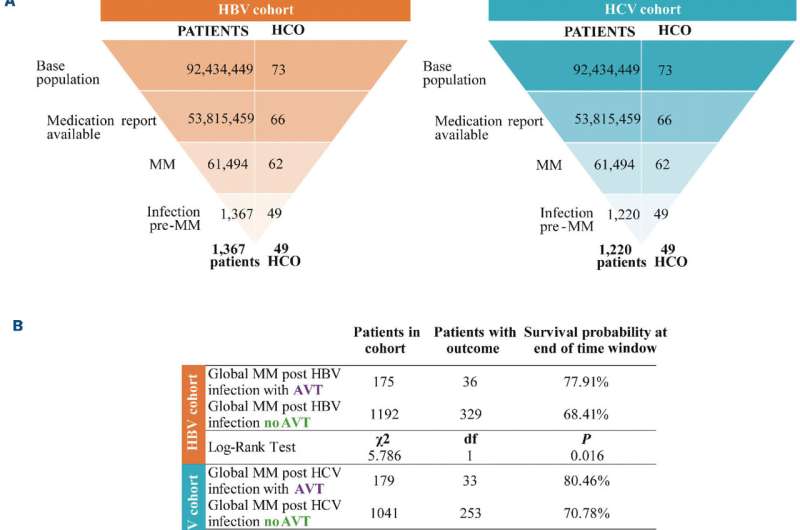This article has been reviewed according to Science X's editorial process and policies. Editors have highlighted the following attributes while ensuring the content's credibility:
fact-checked
trusted source
proofread
Multiple myeloma cured after hepatitis treatment reveals that this cancer can be caused by viruses

A few years ago, a patient was cured of multiple myeloma after being treated for hepatitis C, astounding researchers from the group led by Joaquín Martínez, from the H12O-CNIO Hematological Tumours Clinical Research Unit, a collaboration between the Hospital 12 de Octubre (H12O) and the National Cancer Research Centre (CNIO). Multiple myeloma is one of the most common cancers of the blood.
The desire to understand how this patient was cured has led to the discovery that hepatitis B and C viruses are one of the causes of multiple myeloma, and that eliminating infection with antivirals is often the way to fight this type of cancer.
The discovery made by the CNIO group and the Hospital 12 de Octubre, in collaboration with Sylvie Hermouet, of the University of Nantes (France), warranted a recent article in the journal Haematologica.
"The recognition of this association between viral hepatitis and multiple myeloma, as well as the pathologies known to precede the appearance of myeloma, monoclonal gammopathies, has important clinical implications," says the article.
"Early identification of hepatitis B or C virus infection in these individuals can lead to appropriate antiviral treatment and consequent improvement in outcomes."
It is unknown what causes multiple myeloma, and although it has long been suspected to be related to infectious pathogens, this connection has never been verified or the reason understood.
The researchers María Linares and Alba Rodríguez-García, from the H12O-CNIO Hematological Cancer Clinical Unit and the Complutense University of Madrid (UCM) decided to study the surprising cure of the patient with hepatitis. To do this, they turned to the theory that attributes the cause of multiple myeloma to the chronic exposure of the organism to an infectious agent.
An excess of antibodies halted by antivirals
Multiple myeloma (MM) is an excessive proliferation of blood cells that make antibodies (also called immunoglobulins), the proteins that defend the body from infections. In myeloma, a certain antibody—different in each case, depending on the infectious agent—is produced continuously and excessively. One theory proposes that this anomaly is due to chronic exposure to the infectious agent, which alters the biochemical signals involved in the production of the specific antibody against that agent.
The case of the patient who was cured of myeloma after being treated for hepatitis C seems to support this theory. Linares and Rodríguez-García conjectured that the body was no longer chronically exposed to the hepatitis virus because the antiviral drug eliminated it, and that is why the myeloma disappeared—the cells that make anti-hepatitis C antibodies stopped reproducing in excess.
To investigate whether this had actually happened, two studies were conducted, including 54 patients with monoclonal gammopathy (the pathology that precedes multiple myeloma) and hepatitis: 9 patients with hepatitis C in an initial study and 45 patients with hepatitis B in the study published in Haematologica. Most of them found that the antibody they were consistently and excessively producing was indeed targeting the hepatitis virus.
They then went on to analyze a much broader cohort of multiple myeloma patients (more than 1,300) infected with hepatitis B and hepatitis C (more than 1,200). In both cohorts, they concluded that in those who received antiviral treatment, "the probability of survival was significantly higher".
New options for early detection and treatments
The authors say, "In patients infected with the hepatitis B or hepatitis C virus, multiple myeloma or gammopathy may be caused by these viruses, and the study demonstrates the importance of antiviral treatment in these patients."
The journal article concludes, "The association between viral hepatitis and the development of multiple myeloma and other monoclonal gammopathies has become an important field of research. Chronic hepatitis B or hepatitis C virus infections contribute to the pathogenesis of these hematological neoplasms, which justifies an increase in awareness, detection and treatment strategies."
It adds that in patients with gammopathies targeted by these hepatitis viruses—which can be identified after analysis of the antibody they are producing in excess—"antiviral therapy should be prescribed as soon as possible."
More information: Alba Rodríguez-García et al, Impact of viral hepatitis therapy in multiple myeloma and other monoclonal gammopathies linked to hepatitis B or C viruses, Haematologica (2023). DOI: 10.3324/haematol.2023.283096


















